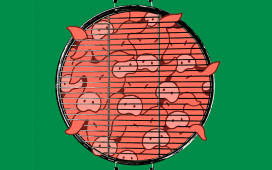I marvel—maybe too often, and with too much existential despair—at the infuriating subjectivity of food and how stubbornly it rejects a cultural diarist’s attempts at quantification. The usual limitations and disclaimers of a year-end gastronomic retrospective apply more than tenfold when it comes to wrapping up a decade: your tongue is no one else’s tongue; your nose is unique; your sense of pleasure and labor and price is yours alone. Weather varies, moods swing, sinuses clog; the steak sliced from this end of the loin is minutely more tender than the steak sliced from that end; table companions are a distraction, an enhancement, or a nightmare. Plus, restaurants close, recipes change, ingredients fall out of fashion, are stymied by shipping limitations, or are written out of legality altogether.
What I’m saying here is: this is a list of the best things I’ve eaten in the last decade, and you can’t have any of it. So much of the pleasure of eating is tied up in the specific, ephemeral gestalt of the moment, even if the food is identical down to the molecule: one woman’s exultant midnight Oreos and milk (very much near the top of my list, as it is in every decade) is another’s unspeakably shameful rock bottom. The first time I ate at Carbone, the nostalgia-steeped temple to red-sauce Italian that opened in 2013 in New York’s Greenwich Village, I was two Gibsons in when my penne alla vodka arrived, and I took my first bite, a transcendent roundness of cream and tomato and heat, just as the Cavaliers’ “Last Kiss” started playing on the sound system. My contentment in that moment was so comprehensive, so powerfully complete, that I was horrified to realize that I was crying—weeping literal, actual tears—as I ate my meal, one of the loveliest and most profound of my life. When I came back a few months later, repeating my order to the letter, it was just a nice plate of pasta.
Some really excellent sandwiches
The past decade in food, for me, turns out to have been very much a decade of sandwiches. Of the ten thousand or so meals I’ve eaten over the last ten years, most have been unmemorable, which, for the sake of not shorting out my senses, is probably a good thing. Of the hundred-ish bites and meals that stand out—a list compiled after serious backscrolling in my online calendar and a surprisingly embarrassing deep dive into my e-mail and Instagram archives—nearly a quarter belong to the category of Stuff Between Bread. I’m unclear on the causal relationships here (are sandwiches generally better than other foods, or am I just generally more inclined to order sandwiches?), but the data doesn’t lie. I’ve goggled at a sky-high pile of vinegared mortadella on a roll at the market in Sao Paulo; made eyes at the golden fried shrimp in a po’ boy at Domilise’s, in New Orleans; knife-and-forked the massive and mind-bending off-menu B.L.T. at Sqirl, in Los Angeles; and housed, in a hungover stupor, a G.L.T. (that’s goetta, lettuce, and tomato) at the alluringly grimy Anchor Grill in Covington, Kentucky, which has been open twenty-four hours a day, seven days a week, since (as far as I am aware) the beginning of time.
Looking back, I also feel particularly privileged to have had intimate moments with some truly great sandwiches that a person just can’t get anymore, like the Vietnamese duck-liver pate smeared on an airy baguette and topped with runny fried eggs and maggi sauce at Mission Cantina, on the Lower East Side (R.I.P.), or the steak-tartare club sandwich (exactly, gorgeously what it sounds like) from Jersey City’s Thirty Acres (also R.I.P.), or the Scuttlebutt at Saltie, in Brooklyn (again, R.I.P.), a messy, jewel-like pile of beets and feta and hard-boiled eggs on focaccia as soft as a cloud. This last one, at least, I replicate at home a few times a year, though it’s only ever about ninety per cent as good—the most important rule of sandwiches is that they always taste better if someone else makes them for you.
The perfect hamburger
In 2015, my husband and I sat in exhausted, rapturous silence on a patio at the Forks Resort Restaurant, just south of Yosemite National Park, in Bass Lake, California, overlooking the then-drought-ravaged dregs of the town’s eponymous lake, eating a pair of the resort’s famous burgers. It was barely noon, and we’d been awake for nearly eight hours, having raced up the freeway from Fresno to reach the top of Glacier Point just as the sun tipped over the top of Half Dome, where we had close to a half hour of private, near-silent veneration at the massive, spectacular cathedral of the Yosemite valley before the viewing terrace became crowded with tour buses and their passengers. Earlier, in the sleepy pre-dawn darkness, we’d neglected to pack any breakfast, and, as we drove down the mountain in twists and loops, tiredness and hunger threatened to drive us off the road (or at least out of our minds). At the Forks Resort, whose restaurant a friend had glowingly recommended, our appetites combined with the lingering tendrils of near-religious natural awe: the burger was heaven on a bun, a juicy, crackle-edged beef patty dressed with pickles, iceberg lettuce, thick rounds of tomato and onion, and a drench of tart thousand-island dressing. It was the most beautiful hamburger in the whole beautiful, beautiful world.
Unbearable luxury
In 2014, on my birthday, I ate a fifty-dollar caviar sandwich (another sandwich!) that was, at the time, the hallmark of the menu at M. Wells Steakhouse, the opulent, idiosyncratic Quebecois-inspired restaurant in Long Island City. The experience, which was magnificent, was something like a grilled cheese paved in diamonds: two pillowy slabs of brioche griddled with still more butter, sandwiching an ink-black square of compressed sturgeon roe, which I described at the time, in a review, as “a Kraft single for the czar,” a comparison I continue to stand behind.
Two marvellous tasting-menu meals stand out among the ten-year blur of unconscionable grandeur: In 2011, an immaculate summer lunch at Blue Hill at Stone Barns, in Pocantico Hills, a town just north of New York City, that somehow stretched from eleven in the morning until nearly seven at night, including a walk around the farm to visit the newborn piglets and chicks. And, this year, a glorious dinner at Kadeau, in Copenhagen, where chef Nicolai Nørregaard plays astonishing tricks with the sweet and briny flavors of the Scandinavian Baltic—I could have happily contented myself with just a particularly dazzling course of razor clams sliced paper-thin and served with white currants and elderflowers. Also, twice, I realized that the pomp and fuss of a major tasting menu paled in comparison to a more casual sibling restaurant directly across the street: in Barcelona, in 2015 (and then again in 2016 and 2017), I thrilled at the tinned fish, ruby-red slices of ham, and thimble cups of dark vermut served at Albert Adrià’s Bodega 1900, whose windows face out onto the facade of Tickets, the zillion-star tasting-menu temple where a dinner of Wonka-esque surreality and self-conscious Adriá-family acrobatics dragged on interminably. Back in Copenhagen, the chef Christian Puglisi’s fine-dining crown jewel Relæ is in fact entirely magical on its own, suffering only from sheer proximity to its wine-bar brother Manfreds, possibly the world’s most fully perfect restaurant—cramped and low-ceilinged, with mismatched tables and walls blanketed in punk stickers and wine labels, a wonderful ever-changing menu comprised almost entirely of vegetables, plus a flawless, never-changing dish of beef tartare.








